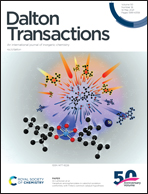Coordination capabilities of bis-(2-pyridyl)amides in the field of divalent germanium, tin and lead compounds†
Abstract
The reactivity of two lithium amides derived from bis-(2-pyridyl)amine (dpa)H or its methyl-substituted congener bis-(6-methyl-2-pyridyl)amine (Me-dpa)H, i.e. (dpa)Li (1) and (Me-dpa)Li (2), toward ECl2 (where E = Ge (dioxane complex) and Sn) is reported. This study produced both heteroleptic complexes (dpa)GeCl (3), [(dpa)SnCl]2 (4), and (Me-dpa)GeCl (5) and homoleptic complexes (dpa)2E (E = Ge (6) or Sn (7)) and (Me-dpa)2E (E = Ge (8) or Sn (9)). The structures of all complexes were established by single-crystal X-ray diffraction analysis showing significant differences depending on the E atom and ligand used. By contrast, in solution, the majority of compounds showed a fluxional behaviour as demonstrated by the NMR study. Finally, it turned out that the Me-dpa ligand, unlike dpa, is able to form ate complexes [(Me-dpa)3E]Li (E = Ge (10), Sn (11) or Pb (12)), whose structures were determined by single-crystal X-ray diffraction analysis. This study revealed the formation of two isomers for Ge and Sn complexes depending on the coordination preference of the lithium atom being coordinated either by nitrogen donors (10–12) or solely by the Ge or Sn electron lone pair (10a and 11a). Furthermore, the NMR experiments proved that the germanium complex 10 exhibits only limited stability in solution and decomposes to germylene 8 and lithium amide 2.



 Please wait while we load your content...
Please wait while we load your content...